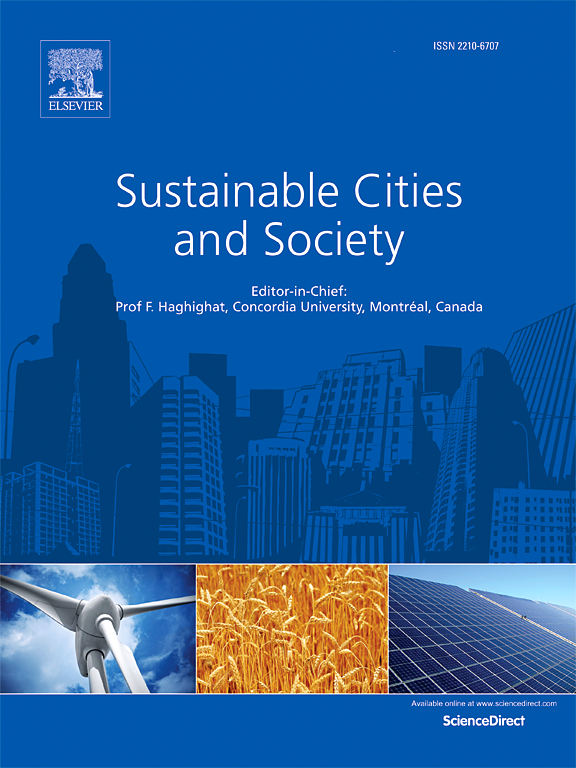Cooling effects of tree transpiration: A CFD simulation study on heterogeneous tree canopy configurations (TCCs)
IF 10.5
1区 工程技术
Q1 CONSTRUCTION & BUILDING TECHNOLOGY
引用次数: 0
Abstract
While tree transpiration is widely recognized for its cooling and humidifying effects, current research lacks quantitative studies on thermal comfort under varying environmental conditions and tree canopy configurations (TCCs). This gap limits the ability of urban green infrastructure to effectively regulate microclimates, particularly in optimizing TCCs for thermal comfort across diverse climates. To address this, we employed a porous model in computational fluid dynamics to simulate six TCCs under various environmental conditions (ambient temperature Ta=20 °C, 30 °C, relative humidity RH=30 %, 60 %) and evaluated their cooling intensity using multiple thermal comfort indices. We found that heterogeneous TCCs influence wind field distribution, categorized as periodic/non-periodic variation (PV/NPV), with a similar wind-blocking efficiency of ∼81 %. The Unit Area Cooling Index (UACI) quantitatively compares the effect of per unit tree canopy area on the distribution of cooling region. In PV, the tree coverage ratio is smaller, but the cooling region per canopy area is larger than in NPV, exhibiting a trend opposite to cooling effectiveness. The thermal comfort decreases with increasing RH for both temperature conditions. At Ta=30 °C, evaluated by thermal indices (Heat Index, Humidex, Wet-Bulb Globe Temperature), NPV shows greater improvement in thermal comfort. At Ta=20 °C, PV performs better when assessed by the Net Effective Temperature.
树木蒸腾降温效应:非均匀树冠构型的CFD模拟研究
虽然树木的蒸腾作用被广泛认为具有冷却和加湿的作用,但目前的研究缺乏对不同环境条件和树冠构型(tcc)下热舒适的定量研究。这种差距限制了城市绿色基础设施有效调节小气候的能力,特别是在优化不同气候条件下的热舒适性方面。为了解决这个问题,我们采用计算流体力学中的多孔模型模拟了不同环境条件下(环境温度Ta=20°C, 30°C,相对湿度RH= 30%, 60%)的6个tcc,并使用多个热舒适指数评估其冷却强度。我们发现异质tcc影响风场分布,分为周期性/非周期性变化(PV/NPV),具有相似的约81%的阻风效率。单位面积降温指数(UACI)定量地比较了单位树冠面积对降温区域分布的影响。在PV中,树木覆盖率较小,但每冠层面积的冷却面积大于NPV,呈现与冷却效果相反的趋势。在两种温度条件下,热舒适性随相对湿度的增加而降低。在Ta=30°C时,通过热指数(热指数,湿度指数,湿球温度)评估,NPV显示出更大的热舒适性改善。当Ta=20°C时,PV在净有效温度评估时表现更好。
本文章由计算机程序翻译,如有差异,请以英文原文为准。
求助全文
约1分钟内获得全文
求助全文
来源期刊

Sustainable Cities and Society
Social Sciences-Geography, Planning and Development
CiteScore
22.00
自引率
13.70%
发文量
810
审稿时长
27 days
期刊介绍:
Sustainable Cities and Society (SCS) is an international journal that focuses on fundamental and applied research to promote environmentally sustainable and socially resilient cities. The journal welcomes cross-cutting, multi-disciplinary research in various areas, including:
1. Smart cities and resilient environments;
2. Alternative/clean energy sources, energy distribution, distributed energy generation, and energy demand reduction/management;
3. Monitoring and improving air quality in built environment and cities (e.g., healthy built environment and air quality management);
4. Energy efficient, low/zero carbon, and green buildings/communities;
5. Climate change mitigation and adaptation in urban environments;
6. Green infrastructure and BMPs;
7. Environmental Footprint accounting and management;
8. Urban agriculture and forestry;
9. ICT, smart grid and intelligent infrastructure;
10. Urban design/planning, regulations, legislation, certification, economics, and policy;
11. Social aspects, impacts and resiliency of cities;
12. Behavior monitoring, analysis and change within urban communities;
13. Health monitoring and improvement;
14. Nexus issues related to sustainable cities and societies;
15. Smart city governance;
16. Decision Support Systems for trade-off and uncertainty analysis for improved management of cities and society;
17. Big data, machine learning, and artificial intelligence applications and case studies;
18. Critical infrastructure protection, including security, privacy, forensics, and reliability issues of cyber-physical systems.
19. Water footprint reduction and urban water distribution, harvesting, treatment, reuse and management;
20. Waste reduction and recycling;
21. Wastewater collection, treatment and recycling;
22. Smart, clean and healthy transportation systems and infrastructure;
 求助内容:
求助内容: 应助结果提醒方式:
应助结果提醒方式:


